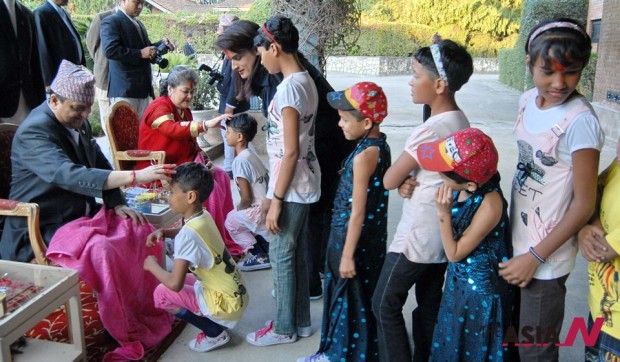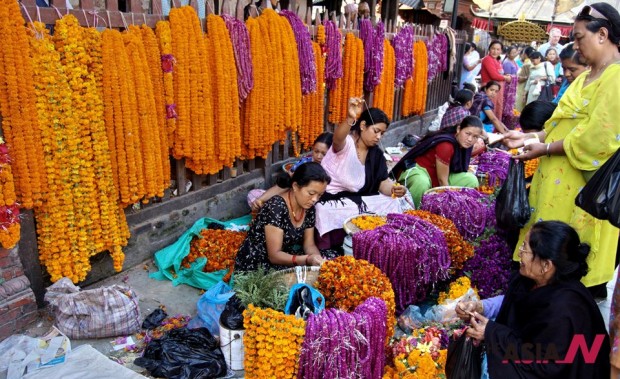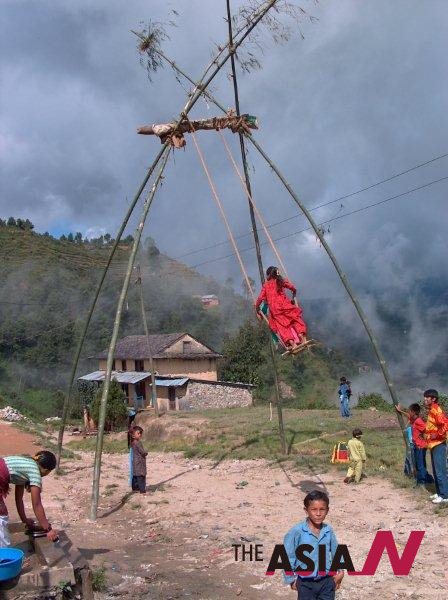Festivals bring smiles on faces of Nepalese
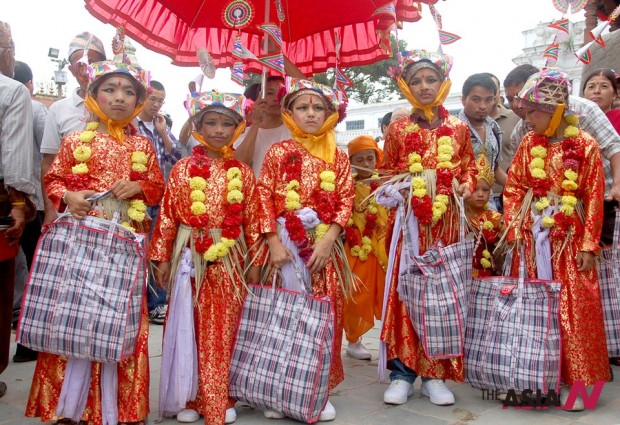
Young boys dress up as cows and go around the city during the Gaijatra festival in Kathmandu. (Photo : Bishnu Gautam)
Sarala Subedi, 39, a senior school teacher in Kathmandu, has also been doing an online job in the evenings for the last two weeks to earn extra money to spend while shopping for Dashain, the greatest festival of all Hindu Nepalese, which begins from October 5 and ends on October 18 this year.
She has to manage many things this month: purchase bus tickets, clothes for her son, husband and herself while buying gifts for her in-laws, nephews and nieces living in Ilam, some 600 km east from the capital. It is only during this festival that she travels to Ilam to see her in-laws and mother. Taking tika (a red mark on the forehead) and blessings from the seniors is the main ritual of this annual Hindu festival.
Like Sarala, her husband too has been doing extra work to make additional money so that he can enjoy the festival lavishly with his friends in his home village.
Wearing new clothes, enjoying delicious foods including mutton and drinks, playing cards and visiting new places are the main activities of all Nepalese during this 15-day festival. The government and private offices remain closed for about a week, school for a fortnight and universities and colleges for a month in Dashain.
In the first nine days, Goddess Durga is worshipped with different names in each home of the people. The people in Kathmandu visit the temples of all nine Goddesses, symbols of power, while in villages the people pay homage to local temples. Indeed, Nepal’s villages get a new lease of life during this festival as all men and women working away from home return to the villages to mark the annual festival in a merrymaking way.
The tenth day is the main day of the festival on which the people visit their parents, elder brothers, uncles and aunts and receive red tika (a mixture of rice, yoghurt and vermillion powder) on the forehead and Jamara (young yellow shoots of corn, wheat, barley, paddy) on the head along with blessings. The process of visiting relatives lasts for four days.
This festival brings smiles on the faces of everyone, from children to the old, as it provides an opportunity to unite with family members and visit relatives. The children get new clothes; the youth erect and play on traditional swings. The houses are whitewashed and the surroundings are kept neat and clean.
Interestingly, the fortnight prior to Dashain, people pay tributes to dead parents and ancestors. Nepalese remember their ancestors and perform a ritual called Shradda (offering worship to dead parents) before any important festival and ritual like marriage. This is a popular way of expressing gratitude to the forefathers whom nobody could be born on this earth without.
Fifteen days after the end of Dashain comes Tihar, the festival of light. It lasts for five days with people enjoying delicious foods and drinks with sel roti (traditional round Nepali bread) being the main food item.
During this festival, the people worship the crow, dog, cow and ox on the first four days. People decorate their houses with flowers and illuminate the entire area in the evening. Sales of flower increase manifold during this festival in Kathmandu and other cities of Nepal.
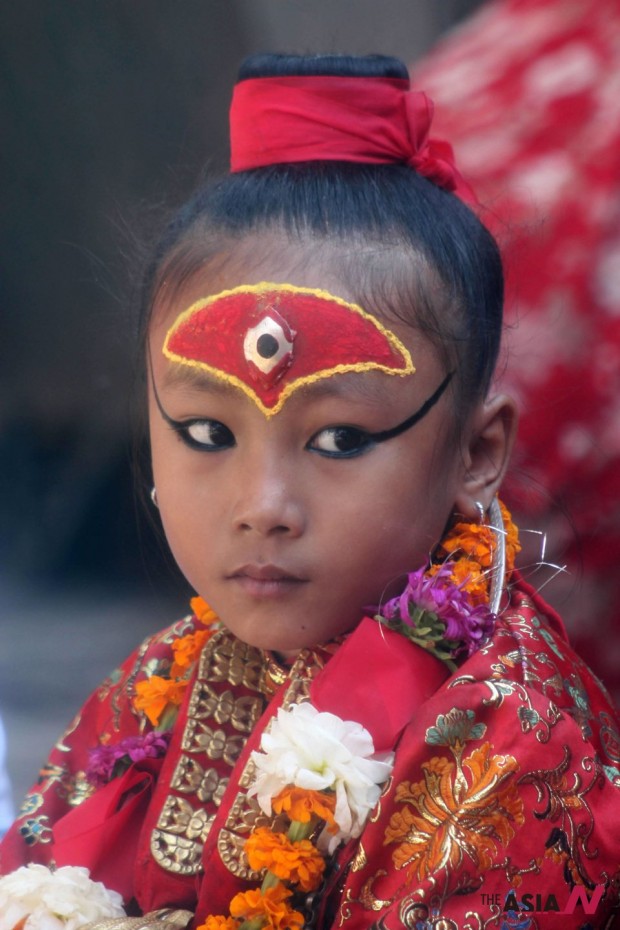
Nepal's living goddess Pratikcha Maharjan participates in the rituals of Kumari Puja, a mass worship of virgin girls at Hanuman Dhoka Durbar Square in Kathmandu. (Photo : Xinhua Photo)
Living Goddess Kumari
Lakshmi Puja (worship of the goddess of wealth) and Bhai Tika (worshipping of brothers by sisters) are two key events for all Nepalese people except for the Newars of Kathmandu who also worship their own bodies during this festival. The government gives public holidays for these three days. The children and youth visit neighbours in the night singing Deusi and Bhailo and collect money for merrymaking. The festival comes to end after sisters offer tikas to their brothers along with gifts.
Four days after Tihar falls Chhath, the key festival of Hindus living in the plains of Nepal and India. In this festival, people gather on the banks of the ponds and rivers and offer worship to the rising sun in the morning and the setting sun in the evening. As a large number of people have migrated to Kathmandu from the southern plain, Chhath is also a very popular festival in Kathmandu.
Indeed, Nepalese mark several festivals before the arrival of the two key festivals—Dashain and Tihar. Teej is the most important festival for Nepalese women, which falls before these two important festivals. It is marked for two days: feasting on the first day and fasting on the last day.
During this festival, the parents invite all their married daughters and throw a feast for them a day before they fast the whole day even without sipping water. On the day of Teej, the women worship in the Shiva temples, and sing and dance throughout the day. In Kathmandu, a large number of women, all attired in red, gather at the Pashupatinath temple premises from early in the morning to late in the evening.
It is said that by fasting the whole day, the unmarried girls will get good husbands while the life expectancy of the husbands of married women will increase. In recent years, people have started throwing Teej feasts months before it arrives. However, the women of Kathmandu’s Newar community do not celebrate this unique festival.
Indrajatra is another unique festival that falls after Teej. In this festival, the people offer prayers to the living Goddess Kumari, Ganesh and Bhairav in Kathmandu.
The people of Kathmandu celebrate the religious festival of Indra Jatra remembering Lord Indra (the god of rain). In Nepalese culture, Indra is a very important god.
Indra Jatra is marked for eight days. On the first day of Indra Jatra, a pole known as Linga with a flag on the top is erected in the Kathmandu Durbar Square area. This thirty-six feet long wooden pole is chosen with great care from the Nala forest located some 40 km east of Kathmandu. According to traditional beliefs, Indra had received this flag from Lord Vishnu for protection.
Indra Jatra is a very interesting festival because for the whole week people enjoy various traditional dances and witness the chariot of Goddess Kumari, Lord Ganesh and Lord Bhairav being pulled throughout the inner parts of Kathmandu.
Festival season from August
This festival has been a major attraction for the tourists visiting Kathmandu. The end of the Indra Jatra festival heralds the beginning of Dashain and Tihar. The Newars of the Kathmandu Valley also celebrate the festival of Gaijatra by commemorating the dead kith and kin. This year the festival was marked on August 22.
Gaijatra or the Festival of Cows is one of the most popular festivals in Kathmandu Valley. It is observed by families who have lost family members that year. During the festival, cows or men disguised as cows march in the streets of Kathmandu and Bhaktapur.
Jokes, satire, mockery and lampoon along with songs fill the festival air. Mockery and humor of every kind become the order of the day until late evening. Gaijatra is a healthy festival that enables the people to accept the reality of death and to prepare themselves for life after the deaths of their relatives. The festival was instituted as a tradition during the reign of King Pratap Malla in the 17th century. The king had introduced this unique festival to see smiles on the lips of his beloved queen after the couple had lost a son. After having a look at the Gaijatra carnival, the queen was said to have laughed realizing that she was not the only one to lose her son in the kingdom.
On the day of festival, teenage boys dress up as cows and parade the streets of the town. It is believed that cows help the members of the family who died within that year to travel to heaven smoothly.
Outside the valley, especially in eastern Nepal, the people mark Ropain Jatra to signal the end of the paddy plantation season. Jubilant youth wearing old and torn clothes with their faces covered with dark colours go around the market places pretending that they are planting paddies.
Before Gaijatra the people celebrate two other festivals—Janai Purnima (the full moon day to wear holy thread) and Nag Panchami. On Nag Panchami, people worship the serpent god by pasting its pictures on the walls of their houses.
The festival season begins from August with the worshiping of the serpent God and ends in November with Chhath, by worshipping the setting sun.



















